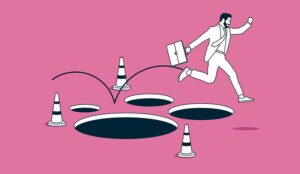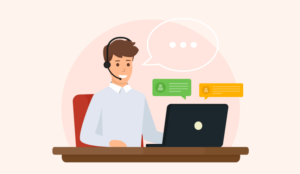An effective customer service team is an essential organizational component in pretty much every industry. By assisting customers with queries and issues and delivering resolutions in a helpful, efficient manner, customer service teams establish trust, cement loyalty, and enhance brand reputation.
Delivering exceptional service requires ongoing agent training. However, your run-of-the-mill training exercises can grow stale, particularly for those who have been working in customer service for a long time.
By delivering a unique training experience, you can make your reps sit up and pay attention. With our out-of-the-box customer service training ideas, you can boost morale, elevate the customer experience, and have a little fun.
What Is Customer Service Training?
Customer service training helps reps develop the skills and knowledge they need to assist customers and deliver satisfactory resolutions quickly. It is, of course, most relevant to customer service teams, but it can be beneficial for any customer-facing role.
While these training programs typically focus on things like interpersonal skills, product knowledge, and conflict resolution, they can also serve as an opportunity to convey your company’s mission and your vision for the customer service team.
By defining goals and ensuring that every rep understands their role within your organization, you can deliver effective training programs and cultivate a culture of learning among staff.
Why Is Effective Customer Service Training So Important?
Customer service training is a way to better engage employees and empower them to meet service goals and standards.
Equipping reps with the skills to handle complex customer service queries and resolve difficult issues is critical in a service environment as it improves your organization’s short- and long-term outcomes.
Service interactions present opportunities to show your customers that you care. If you can use these opportunities to deliver an exceptional customer experience, it will go a long way to improving customer retention and brand loyalty.
Let’s look at some of the key reasons why customer training is so important.
It Improves Customer Experience
With 88 percent of customers stating that the experience a company provides is just as important as the products or services on offer, it’s clear that delivering strong CX is essential.
Product knowledge is, of course, important for resolving queries effectively, but you must also train your reps to build relationships with customers through positive, helpful interactions. In the modern service environment, it’s not just about efficacy—it’s about empathy.
A generic email might solve a product issue, but a personalized interaction solves the issue and resonates with the customer. The latter is much more likely to improve customer retention.
It Builds Customer Loyalty
96 percent of customers agree that excellent service builds trust. If you continuously deliver top-notch service, customers will take notice and be more likely to stick with your brand.
In terms of business outcomes, establishing customer loyalty can be lucrative, with existing customers spending, on average, 67 percent more than new ones.
Quality service is the key to building these loyal relationships—you should always be analyzing and refining service performance to improve customer lifetime value.
Delivering strong service is also a brand-building exercise. Loyal customers are, in some ways, independent marketers, with 82 percent of customers stating that they have recommended a company based on excellent service. These recommendations don’t only create potential new customers; they build your brand’s reputation.
It Reduces Agent Turnover
It can be difficult to keep service reps engaged. Enthusiasm naturally wanes over time, and without intervention, job satisfaction can decline, leading to higher agent churn. With the average cost of turning over a single rep totaling $14,113, it’s important that you keep your agents happy.
Employees value opportunities for learning and career growth. By providing engaging service training on a regular basis, you can show your reps that you are invested in their personal and professional development, reducing churn rates.
It Offers a Competitive Advantage
With customer expectations higher than ever, the importance of good service has never been more apparent.
94 percent of customers agree that a positive experience would make them more likely to purchase again, so organizations prioritizing customer service can get the competitive edge.
By identifying the most important metrics to your business, you can tailor your service training, deliver stronger performance, and improve KPIs like CSAT, NPS, first contact resolution, and more. It’s easier than ever to jump ship to a competitor, so make your company the obvious choice.
It Increases Revenue
Positive customer service experiences are financially valuable. In fact, Gallup states that clients that improved customer engagement have seen a 66 percent increase in sales.
Better training means more effective agents. Agents that are productive, knowledgeable, and capable of delivering the type of customer experience that boosts engagement and, as a result, drives sales. Playing a customer-facing role, customer service teams are key revenue generators.
Types of Customer Service Training
Customer service training is a broad term with different methods and approaches that depend on specific requirements and desired outcomes. Let’s take a look at some of the most common types of customer service training.
New Hire Training
The early weeks at a new organization can define the entire employment experience—for better or worse. Onboarding is an opportunity to get new reps up to speed as quickly as possible in terms of software & tools, product knowledge, and organizational culture.
New hires will also learn about the processes and hierarchy within the company and have opportunities to meet their coworkers. You may even consider assigning mentors to new hires to facilitate their growth and give them someone to lean on for advice.
You should also establish clear expectations for new hires, as any disconnect between reality and expectations can damage morale and performance, ultimately leading to increased agent turnover.
Periodic Customer Service Training
Learning is a lifelong process—and so is customer service training. While onboarding gives new reps a platform for success, delivering additional training throughout their employment solidifies that platform and keeps your team sharp.
Whether it’s monthly, quarterly, or yearly, you should evaluate employee competence regularly and deliver training based on the results.
No matter how experienced a rep may be, job requirements can change and evolve over time, and anyone can get a little rusty. Periodic training will allow you to target weaknesses and maintain high standards.
It’s also an opportunity to boost morale and strengthen the bond between coworkers. Working in customer service can be challenging, so it’s important that you embrace regular team-building activities and training exercises to keep your team enthusiastic and focused.
Ad Hoc Training
The best laid plans of mice and men… and customer service teams. Sometimes ad hoc training is necessary to meet fast-changing demands.
Whether it’s something as unexpected as a global pandemic or a more common issue like a product recall, some situations require impromptu training.
As the first port of call for customers, your service team needs to be fully informed about the latest developments and equipped with the tools and knowledge to handle any customer inquiries.
By recording a short video, you can keep agents in the loop while you prepare a more in-depth update and deliver training sessions. The quicker you get the information out there, the easier it will be for your customer service team.
External Expert Training
Working with external experts, you can facilitate workshops, webinars, online courses, and more. Typically, these sessions will focus on targeted areas and skills.
Not only does this add new knowledge and a fresh perspective to your existing training strategy, but it can also be more engaging for reps as it takes them out of their usual training routine.
For live workshops, you should record the sessions and store them in your internal knowledge base as a resource for employees. This way, attendees can review the information, and those who couldn’t make it won’t miss out.
What to Avoid for Effective Customer Service Training
Not all training methods are equally effective. When developing a training strategy for your organization, some things are best to avoid.
A one-size-fits-all approach can be ineffective. No two customer service teams—and no two agents, for that matter—are the same, so it’s always better to tailor your training according to individual needs and pain points within your organization.
Additionally, covering the same information time and time again will backfire. Some key items are important to reiterate, but repeating the same points too many times could cause agents to switch off during training.
You should also take care to include everyone in the training process. If you exempt an agent who is performing well, there’s a chance they could take their foot off the gas. Not to mention that other agents could resent them for it.
Perhaps the biggest mistake you can make is to treat customer service training as a one-off event. Learning is an ongoing process, and requirements are always evolving, so it’s essential that you keep your agents sharp with regular training and feedback.
Unconventional Customer Service Training Ideas and Exercises
Classic training methods like frustrated customer roleplay, “don’t say no”, turning a positive into a negative, etc., certainly serve their purpose, but keeping things fresh is a great way to engage agents, boost morale, and ultimately improve performance.
With this in mind, we’re going to give you 8 out-of-the-box ideas for customer service training, so you can go beyond the basics and delight agents and customers alike.
Situational Roleplaying
Yes, we’ve just noted that “frustrated customer roleplay” is an example of a more conventional training method, but with some minor adjustments, you can give it a fresh twist.
Go beyond the typical angry customer character and give reps more specific challenges. Maybe your imaginary caller won’t stop swearing, or they try to flirt with your rep, or they’re fishing for a discount. Whatever it is, make it offbeat.
This approach prepares agents for unusual, challenging situations, forcing them to think on the spot and come up with inventive solutions. Just as importantly, it’s fun! The more engaged your agents are in the training process, the more likely they are to learn from it.
Mystery Shoppers
The mystery shopper is a staple of the retail sector, but it can also be effective in other industries. It’s particularly useful for gauging and improving performance in customer service teams.
To add a more novel element to the scenario, go beyond simply hiring a mystery shopper—ask your customer service reps to try and identify them. You can make a game out of it, assigning points to the reps who succeed and even maintaining a leaderboard to encourage some healthy competition.
The gamified nature of this exercise encourages agent engagement in the training process and pushes your team to deliver even better service at every opportunity.
Cross-Departmental Training
Switching departments for a day can give customer service representatives a better understanding of how your organization operates and the types of problems other teams face each day.
These cross-departmental training exercises enable agents to be more innovative in their problem-solving while also facilitating the kind of collaboration that can lead to fresh insights and ideas. You can also invite other teams, like marketing or finance, to your customer service workshops to get their input.
Of course, don’t schedule these switch-ups for days when there are essential meetings, VIP clients coming to the office, new product launches, etc.
Mindfulness
You can’t do your best if you don’t feel your best. With 96 percent of contact centre agents stating that they feel acute stress at least once a week, it’s clear that employee wellness is lacking in certain customer service roles.
By providing workshops and training on meditation, breathing techniques, and other wellness exercises, you can ensure that your agents are mentally equipped to handle difficult situations and remain calm under pressure.
You could dedicate scheduled time to meditation each day or encourage team members to download apps like Headspace or Calm so they can practice mindfulness in their own time.
Improbable Sales
By tasking your reps with selling a non-existent or completely outlandish product, you can push them out of their comfort zone, improve their sales skills, and encourage some team-building fun.
A unicorn, a 16th-century lute, an artifact recovered from the lost city of Atlantis—the sillier, the better for this exercise. Anything you can think of that would be near-impossible to sell to any reasonable customer will do the trick.
You can make it competitive by keeping score and even turn up the difficulty by challenging your reps to sell these items to personas based on existing customers. However you twist it, it’s a great exercise for honing upselling and cross-selling skills.
Crisis Management
When it comes to handling emergencies, anticipation and preparation are key. This training exercise will equip your reps with the tools they need to stay confident and handle any customer query during a crisis.
Divide your agents into different teams and task them with solving the same problem. It should be a big problem with no obvious solution. By challenging them to find a solution, you will see how they work together, who displays critical thinking, who emerges as a leader, etc.
All of these outcomes will improve your organizational handling of future emergencies by preparing your reps in advance, reducing the chances of customer churn during such a crisis.
Lunchtime Learning
By asking team members to present on a topic of their choosing—work-related or personal— during lunchtime, you’re giving them a safe space to practice their communication and presentation skills while bonding with their coworkers.
Whether it’s a new product or their latest vacation, the topic is irrelevant. What matters is that the reps are able to present and explain their topic in a clear, engaging manner.
This skill set is particularly useful for onboarding new customers, as they may be completely unfamiliar with how the product or service works, as well as resolving existing customer queries.
Assess the Competition
Why not learn a little more about the competition? Get your customer service reps to call up competitors and pose as potential customers to see how their agents handle these interactions.
Make sure your reps ask tough questions and pay careful attention to things like tone, cadence, resolution, and follow-up options.
By doing this, your customer service team can identify what competitors do well—and what they don’t—and decide what they could implement themselves. This way, you can define a standard your customer service team aims to surpass.
Conclusion
In the modern marketplace, a strong customer service team is an essential component of pretty much every organization. Without one, it’s extremely difficult to build customer trust, cement loyalty, and gain a competitive edge.
To get your customer service team to perform at their best, you need to deliver engaging, informative training on a regular basis. While more conventional training methods are tried and tested, sometimes you need to shake it up with some out-of-the-box ideas to improve morale and elevate your customer experience.
Using a customizable scorecard builder and integrated learning management system, you can pinpoint your service team’s weak points and deliver targeted training to both remote and on-site agents.
This blog post has been re-published by kind permission of Scorebuddy – View the Original Article
For more information about Scorebuddy - visit the Scorebuddy Website
Call Centre Helper is not responsible for the content of these guest blog posts. The opinions expressed in this article are those of the author, and do not necessarily reflect those of Call Centre Helper.
Author: Scorebuddy
Published On: 5th May 2023 - Last modified: 9th May 2023
Read more about - Guest Blogs, Scorebuddy






 Scorebuddy is quality assurance solution for scoring customer service calls, emails and web chat. It is a dedicated, stand-alone staff scoring system based in the cloud, requiring no integration.
Scorebuddy is quality assurance solution for scoring customer service calls, emails and web chat. It is a dedicated, stand-alone staff scoring system based in the cloud, requiring no integration. 









